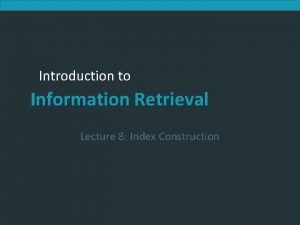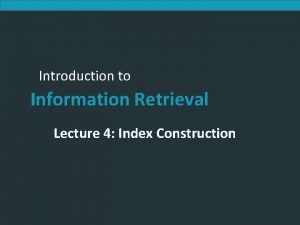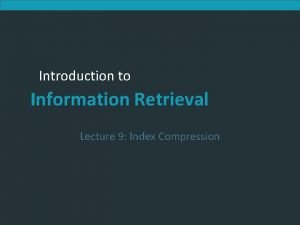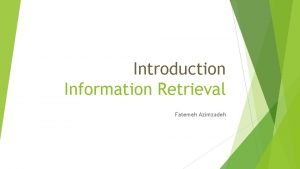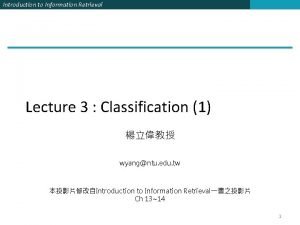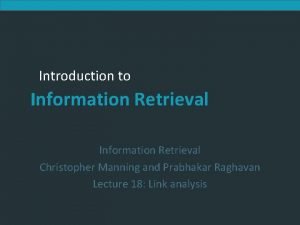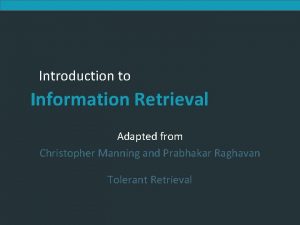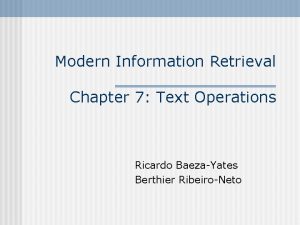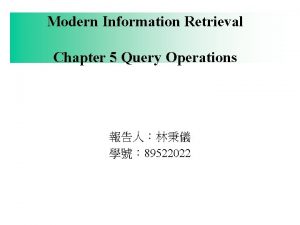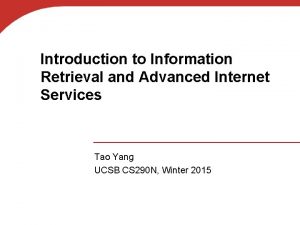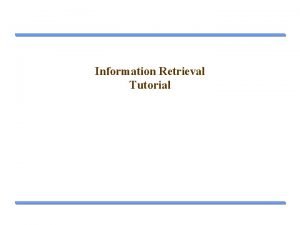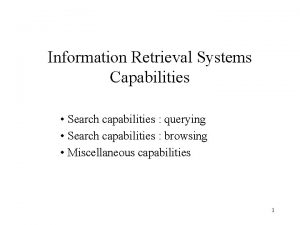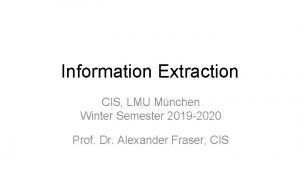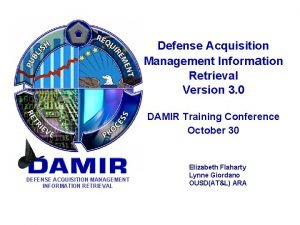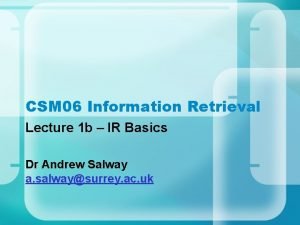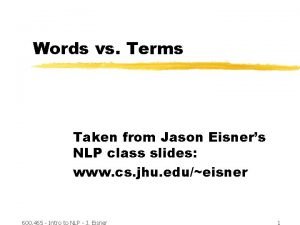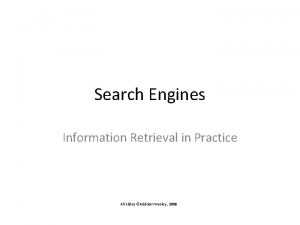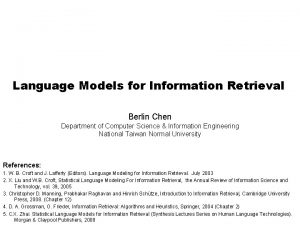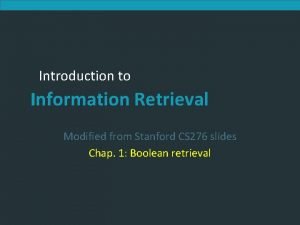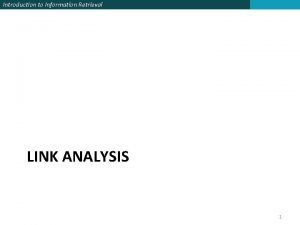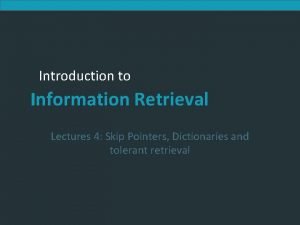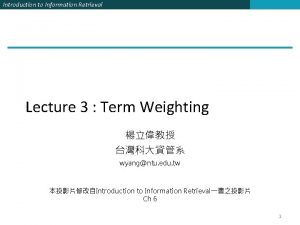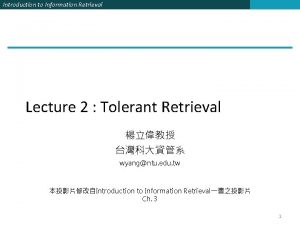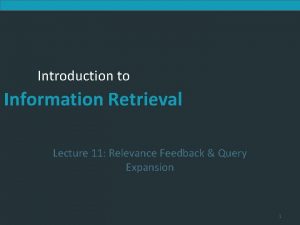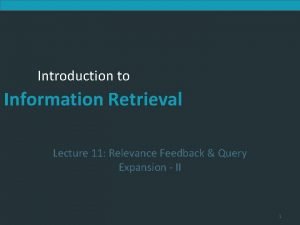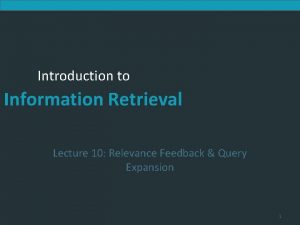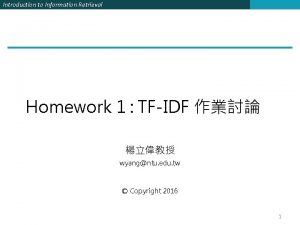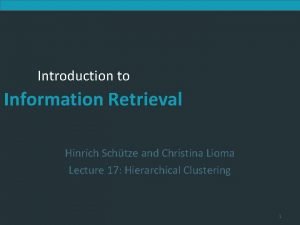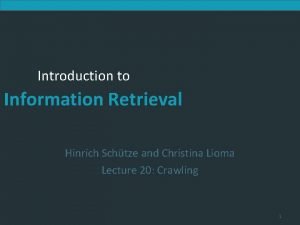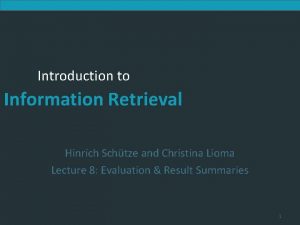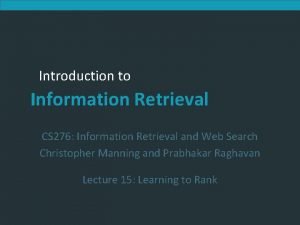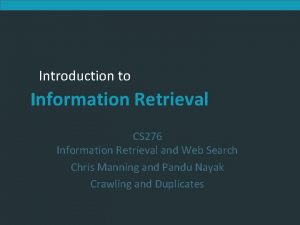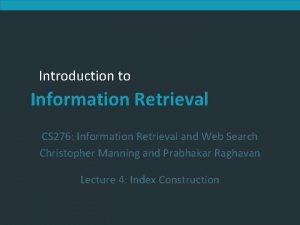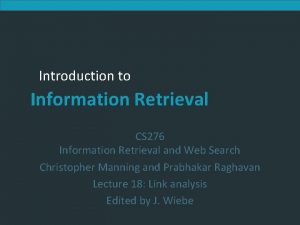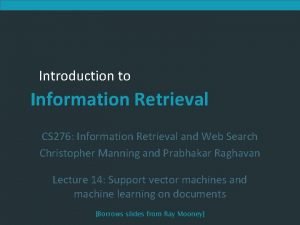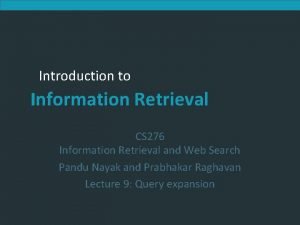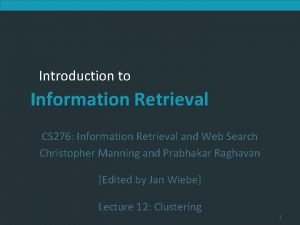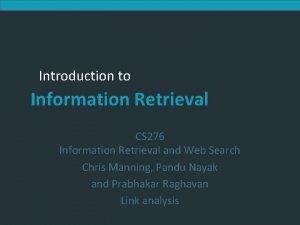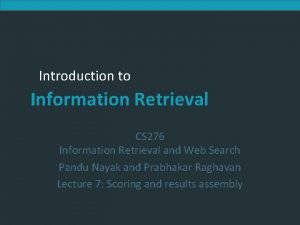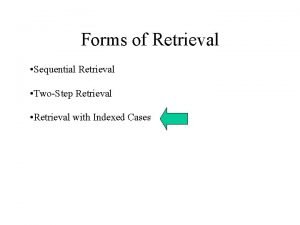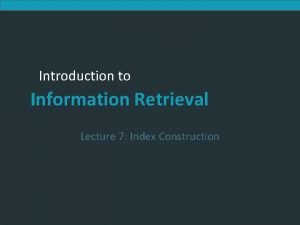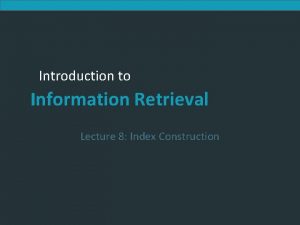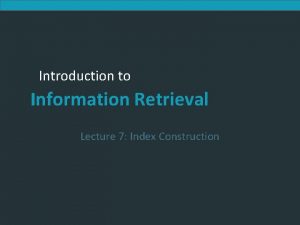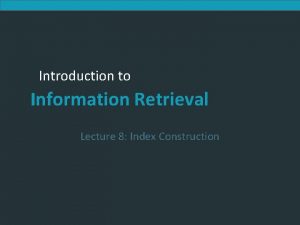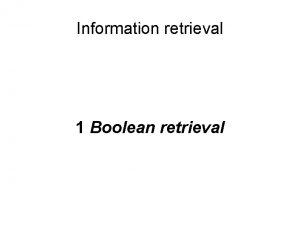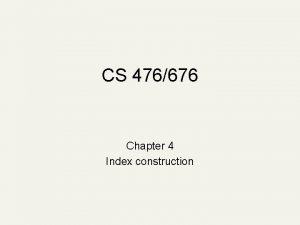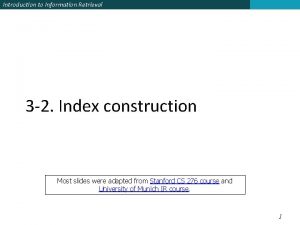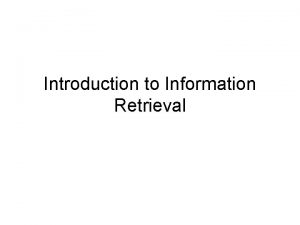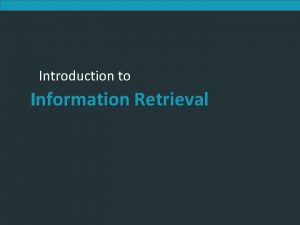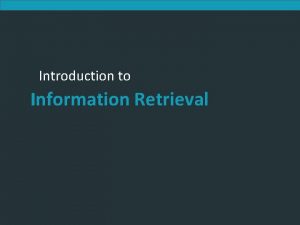Introduction to Information Retrieval Lecture 8 Index Construction














































- Slides: 46

Introduction to Information Retrieval Lecture 8: Index Construction

Introduction to Information Retrieval Ch. 4 Index construction § How do we construct an index? § What strategies can we use with limited main memory?

Introduction to Information Retrieval Sec. 4. 1 Hardware basics § Many design decisions in information retrieval are based on the characteristics of hardware § We begin by reviewing hardware basics

Introduction to Information Retrieval Sec. 4. 1 Hardware basics § Access to data in memory is much faster than access to data on disk. § Disk seeks: § No data is transferred from disk while the disk head is being positioned. takes a while for the disk head to move to the part of the disk where data is located. § Therefore: Transferring one large chunk of data from disk to memory is faster than transferring many small chunks. § Disk I/O is block-based: Reading and writing of entire blocks (as opposed to smaller chunks): 8 to 256 KB.

Introduction to Information Retrieval Sec. 4. 1 Hardware basics § Servers used in IR systems now typically have several GB of main memory, sometimes tens of GB. § Available disk space is several (2– 3) orders of magnitude larger.

Sec. 4. 1 Introduction to Information Retrieval Hardware assumptions for this lecture § § § symbol statistic s average seek time b transfer time per byte processor’s clock rate p low-level operation value 5 ms = 5 x 10− 3 s 0. 02 μs = 2 x 10− 8 s 109 s− 1 0. 01 μs = 10− 8 s (e. g. , compare & swap a word) § § size of main memory size of disk space several GB 1 TB or more

Introduction to Information Retrieval Sec. 4. 2 RCV 1: Our collection for this lecture § Shakespeare’s collected works definitely aren’t large enough for demonstrating many of the points in this course. § The collection we’ll use isn’t really large enough either, but its publicly available and is at least a more plausible example. § As an example for applying scalable index construction algorithms, we will use the Reuters RCV 1 collection. § This is one year of Reuters newswire (part of 1995 and 1996)

Introduction to Information Retrieval A Reuters RCV 1 document Sec. 4. 2

Introduction to Information Retrieval Sec. 4. 2 Reuters RCV 1 statistics § § symbol statistic value N documents 800, 000 M terms (= word types) 400, 000 non-positional postings 100, 000 (100 Million)

Sec. 4. 2 Introduction to Information Retrieval Recap: Lec 1 index construction § Documents are parsed to extract words and these are saved with the Document ID. Doc 1 I did enact Julius Caesar I was killed i' the Capitol; Brutus killed me. Doc 2 So let it be with Caesar. The noble Brutus hath told you Caesar was ambitious

Introduction to Information Retrieval Key step § After all documents have been parsed, the inverted file is sorted by terms. We focus on this sort step. We have 100 M items to sort. Sec. 4. 2

Introduction to Information Retrieval Sec. 4. 2 Scaling index construction § In-memory index construction does not scale § Can’t stuff entire collection into memory, sort, then write back § How can we construct an index for very large collections? § Taking into account the hardware constraints we just learned about. . . Memory, disk, speed, etc.

Introduction to Information Retrieval Sec. 4. 2 Sort-based index construction § As we build the index, we parse docs one at a time. § While building the index, we cannot easily exploit compression tricks (you can, but much more complex) § The final postings for any term are incomplete until the end. § At 12 bytes per non-positional postings entry (term, doc, freq), demands a lot of space for large collections. § T = 100, 000 in the case of RCV 1 § So … we can do this in memory in 2009, but typical collections are much larger. E. g. , the New York Times provides an index of >150 years of newswire § Thus: We need to store intermediate results on disk.

Introduction to Information Retrieval Sec. 4. 2 Sort using disk as “memory”? § Can we use the same index construction algorithm for larger collections, but by using disk instead of memory? § No: Sorting T = 100, 000 records on disk is too slow – too many disk seeks. § We need an external sorting algorithm.

Introduction to Information Retrieval Sec. 4. 2 Bottleneck § Parse and build postings entries one doc at a time § Now sort postings entries by term (then by doc within each term) § Doing this with random disk seeks would be too slow – must sort T=100 M records If every comparison took 2 disk seeks, and N items could be sorted with N log 2 N comparisons, how long would this take?

Introduction to Information Retrieval BSBI: Blocked sort-based Indexing (Sorting with fewer disk seeks) § § Sec. 4. 2 12 -byte (4+4+4) records (term, doc, freq). These are generated as we parse docs. Must now sort 100 M such 12 -byte records by term. Define a Block ~ 10 M such records § Can easily fit a couple into memory. § Will have 10 such blocks to start with. § Basic idea of algorithm: § Accumulate postings for each block, sort, write to disk. § Then merge the blocks into one long sorted order.

Introduction to Information Retrieval Sec. 4. 2 Inversion involves 2 steps: (1) sort the term. ID-doc. ID pairs (2) collect all term. ID–doc. ID pairs with the same term. ID into a postings list

Introduction to Information Retrieval Sec. 4. 2 Sorting 10 blocks of 10 M records § First, read each block and sort within: § Quicksort takes 2 N ln N expected steps § In our case 2 x (10 M ln 10 M) steps § Exercise: estimate total time to read each block from disk and quicksort it. § 10 times this estimate – gives us 10 sorted runs of 10 M records each.

Introduction to Information Retrieval Sec. 4. 2

Sec. 4. 2 Introduction to Information Retrieval How to merge the sorted runs? § Can do binary merges, with a merge tree of log 210 = 4 layers. § During each layer, read into memory runs in blocks of 10 M, merge, write back. Runs being merged. 1 2 3 4 Disk Merged run.

Introduction to Information Retrieval Sec. 4. 2 How to merge the sorted runs? § But it is more efficient to do a multi-way merge, where you are reading from all blocks simultaneously § Providing you read decent-sized chunks of each block into memory and then write out a decent-sized output chunk, then you’re not killed by disk seeks

Introduction to Information Retrieval Sec. 4. 3 Remaining problem with sort-based algorithm § Our assumption was: we can keep the dictionary in memory. § We need the dictionary (which grows dynamically) in order to implement a term to term. ID mapping. § Actually, we could work with term, doc. ID postings instead of term. ID, doc. ID postings. . . §. . . but then intermediate files become very large. (We would end up with a scalable, but very slow index construction method. )

Introduction to Information Retrieval Terms represented as term. IDs? § To make index construction more efficient, we can represent terms as term. IDs § Each term. ID is a unique serial number § How to build the mapping from terms to term. IDs? § On the fly while we are processing the collection; or, § A two-pass approach: compile the vocabulary in the first pass and construct the inverted index in the second pass § Some indexing algorithms use term. IDs, others directly use the term § Hybrid approaches possible: map frequently occurring terms to term. IDs, rare terms directly handled 23

Introduction to Information Retrieval SPIMI: Single-pass in-memory indexing Sec. 4. 3 § Key idea 1: Generate separate dictionaries for each block – no need to maintain term-term. ID mapping across blocks. § Key idea 2: Don’t sort. Accumulate postings in postings lists as they occur. § With these two ideas we can generate a complete inverted index for each block. § These separate indexes can then be merged into one big index.

Introduction to Information Retrieval SPIMI-Invert § Merging of blocks is analogous to BSBI. Sec. 4. 3

Introduction to Information Retrieval SPIMI-Invert: explanation § Instead of first collecting all term. ID–doc. ID pairs and then sorting them (as we did in BSBI), SPIMI adds a posting directly to its postings list (line 10) § We do not know how large the postings list of a term will be when we first encounter it, hence § allocate space for a short postings list initially, § double the space each time it is full (lines 8– 9) 26

Introduction to Information Retrieval SPIMI-Invert: explanation § When memory exhausted, write the index of the block (which consists of the dictionary and the postings lists) to disk (line 12) § Sort the terms (line 11) before writing to disk since we want to write postings lists in lexicographic order to facilitate the final merging step. 27

Introduction to Information Retrieval Till now § Sort-based indexing § Naïve in-memory or in-disk inversion § Blocked Sort-Based Indexing (BSBI) § Merge sort is effective for disk-based sorting (avoid seeks!) § Single-Pass In-Memory Indexing (SPIMI) § No global dictionary § Generate separate dictionary for each block § Don’t sort postings § Accumulate postings in postings lists as they occur § Next § Distributed indexing using Map. Reduce § Dynamic indexing: Multiple indices, logarithmic merge 28

Introduction to Information Retrieval Distributed indexing § For web-scale indexing: must use a distributed computing cluster § Individual machines are fault-prone § Can unpredictably slow down or fail § How do we exploit such a pool of machines? Sec. 4. 4

Introduction to Information Retrieval Web search engine data centers § Web search data centers (Google, Bing, Baidu) mainly contain commodity machines. § Data centers are distributed around the world. § Estimate: Google ~1 million servers, 3 million processors/cores (Gartner 2007) Sec. 4. 4

Introduction to Information Retrieval Sec. 4. 4 Distributed indexing § Map. Reduce: a general architecture for distributed computing § Maintain a master node (machine) directing the indexing job – considered “safe”. § Many worker nodes, each of which can fail § Break up indexing into sets of (parallel) tasks. § Master assigns each task to an idle worker from a pool

Introduction to Information Retrieval Distributed Indexing § In general, Map. Reduce breaks a large computing problem into smaller parts by recasting it in terms of manipulation of key-value pairs § For the task of indexing, a key-value pair has the form (term. ID, doc. ID) 32

Introduction to Information Retrieval Sec. 4. 4 Parallel tasks § We will use two sets of parallel tasks § Parsers § Inverters § Break the input document collection into splits § Each split is a subset of documents (corresponding to blocks in BSBI/SPIMI) § Map phase: map splits of the input data to key-value pairs - done by parser machines § Reduce phase: Collect all values (here: doc. IDs) for a given key (here: term. ID) – done by inverter machines

Sec. 4. 4 Introduction to Information Retrieval Data flow assign splits Master assign Parser a-f g-p q-z Map phase Segment files Postings Inverter a-f Inverter g-p Inverter q-z Reduce phase

Introduction to Information Retrieval Sec. 4. 4 Parsers (Map phase) § Master assigns a split to an idle parser machine § Parser reads a document at a time and emits (term, doc) pairs § Parser writes pairs into j partitions § Each partition is for a range of terms’ first letters (called term-partition) § (e. g. , a-f, g-p, q-z) – here j = 3. § Now to complete the index inversion

Introduction to Information Retrieval Sec. 4. 4 Inverters (Reduce phase) § An inverter collects all (term, doc) pairs (= postings) for one term-partition. § Sorts and writes to postings lists § Finally, the list of values is sorted for each key and written to the final sorted postings list (“postings” in the figure). § Note: § Parsers and inverters are not separate sets of machines. § The same machine can be a parser in the map phase and an inverter in the reduce phase.

Introduction to Information Retrieval Schema for index construction in Map. Reduce Sec. 4. 4 § Schema of map and reduce functions § map: input → list(k, v) reduce: (k, list(v)) → output § Instantiation of the schema for index construction § map: collection → list(term. ID, doc. ID) § reduce: (<term. ID 1, list(doc. ID)>, <term. ID 2, list(doc. ID)>, …) → (postings list 1, postings list 2, …)

Introduction to Information Retrieval Example for index construction § § Map: d 1 : C came, C c’ed. d 2 : C died. → <C, d 1>, <came, d 1>, <C, d 1>, <c’ed, d 1>, <C, d 2>, <died, d 2> § Reduce: § (<C, (d 1, d 2, d 1)>, <died, (d 2)>, <came, (d 1)>, <c’ed, (d 1)>) → (<C, (d 1: 2, d 2: 1)>, <died, (d 2: 1)>, <came, (d 1: 1)>, <c’ed, (d 1: 1)>) 38

Introduction to Information Retrieval Sec. 4. 5 Dynamic indexing § Up to now, we have assumed that collections are static. § They rarely are: § Documents come in over time and need to be inserted. § Documents are deleted and modified. § This means that the dictionary and postings lists have to be modified: § Postings updates for terms already in dictionary § New terms added to dictionary

Introduction to Information Retrieval Sec. 4. 5 Simplest approach § § Maintain “big” main index New docs go into “small” auxiliary index Search across both, merge results Deletions § Invalidation bit-vector for deleted docs § Filter docs output on a search result by this invalidation bit -vector § Periodically, re-index into one main index

Introduction to Information Retrieval Sec. 4. 5 Issues with main and auxiliary indexes § Problem of frequent merges – you touch stuff a lot § Poor performance during merge § Actually: § Merging of the auxiliary index into the main index is efficient if we keep a separate file for each postings list. § Merge is the same as a simple append. § But then we would need a lot of files – inefficient for OS. § Assumption for the rest of the lecture: The index is one big file. § In reality: Use a scheme somewhere in between (e. g. , split very large postings lists, collect postings lists of length 1 in one file etc. )

Introduction to Information Retrieval Sec. 4. 5 Logarithmic merge § Maintain a series of indexes, each twice as large as the previous one § At any time, some of these powers of 2 are instantiated § § § Keep smallest (Z 0) in memory Larger ones (I 0, I 1, …) on disk If Z 0 gets too big (> n), write to disk as I 0 or merge with I 0 (if I 0 already exists) as Z 1 Either write merge Z 1 to disk as I 1 (if no I 1) Or merge with I 1 to form Z 2

Introduction to Information Retrieval Sec. 4. 5

Introduction to Information Retrieval Sec. 4. 5 Further issues with multiple indexes § Collection-wide statistics are hard to maintain § E. g. , when we spoke of spell-correction: which of several corrected alternatives do we present to the user? § We said, pick the one with the most hits § How do we maintain the top ones with multiple indexes and invalidation bit vectors? § One possibility: ignore everything but the main index for such ordering

Introduction to Information Retrieval Sec. 4. 5 Dynamic indexing at search engines § All the large search engines now do dynamic indexing § Their indices have frequent incremental changes § News items, blogs, new topical web pages § But (sometimes/typically) they also periodically reconstruct the index from scratch § Need more hardware resources § Query processing is then switched to the new index, and the old index is deleted

Introduction to Information Retrieval Sec. 4. 5 Other sorts of indexes § Positional indexes § Same sort of sorting problem … just larger § Building character n-gram indexes: § As text is parsed, enumerate n-grams. § For each n-gram, need pointers to all dictionary terms containing it – the “postings”. § Note that the same “postings entry” will arise repeatedly in parsing the docs – need efficient hashing to keep track of this. § E. g. , that the trigram uou occurs in the term deciduous will be discovered on each text occurrence of deciduous § Only need to process each term once
 Index construction in information retrieval
Index construction in information retrieval Index construction in information retrieval
Index construction in information retrieval Skip pointer
Skip pointer Index compression in information retrieval
Index compression in information retrieval Manning introduction to information retrieval
Manning introduction to information retrieval Introduction to information retrieval
Introduction to information retrieval Introduction to information retrieval
Introduction to information retrieval Manning information retrieval
Manning information retrieval 01:640:244 lecture notes - lecture 15: plat, idah, farad
01:640:244 lecture notes - lecture 15: plat, idah, farad Sequential searching
Sequential searching Components of search engine in information retrieval
Components of search engine in information retrieval What is precision and recall in information retrieval
What is precision and recall in information retrieval Modern information retrieval
Modern information retrieval Query operations in information retrieval
Query operations in information retrieval Which internet service is used for information retrieval
Which internet service is used for information retrieval Information retrieval tutorial
Information retrieval tutorial Wildcard query in information retrieval
Wildcard query in information retrieval Search capabilities in information retrieval system
Search capabilities in information retrieval system Link analysis in information retrieval
Link analysis in information retrieval Information retrieval lmu
Information retrieval lmu Defense acquisition management information retrieval
Defense acquisition management information retrieval Advantages of information retrieval system
Advantages of information retrieval system Information retrieval nlp
Information retrieval nlp Signature file structure in information retrieval system
Signature file structure in information retrieval system Search engines information retrieval in practice
Search engines information retrieval in practice Relevance information retrieval
Relevance information retrieval Stanford information retrieval
Stanford information retrieval Link analysis in information retrieval
Link analysis in information retrieval Skip pointers
Skip pointers Anthony julius
Anthony julius Levenshtein distance for oslo-snow
Levenshtein distance for oslo-snow Information retrieval
Information retrieval Information retrieval
Information retrieval Relevance information retrieval
Relevance information retrieval Information retrieval
Information retrieval Information retrieval
Information retrieval Url image
Url image Information retrieval
Information retrieval Relevance information retrieval
Relevance information retrieval Cs 276
Cs 276 Cs 276
Cs 276 Information retrieval
Information retrieval Information retrieval
Information retrieval Relevance information retrieval
Relevance information retrieval Information retrieval
Information retrieval Information retrieval
Information retrieval Cs 276
Cs 276
